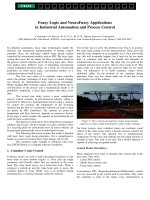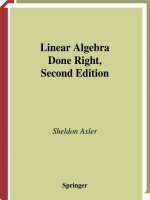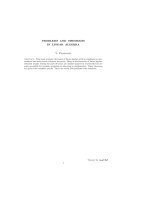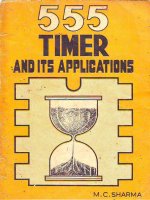linear algebra and it applications
Bạn đang xem bản rút gọn của tài liệu. Xem và tải ngay bản đầy đủ của tài liệu tại đây (6.24 MB, 576 trang )
F O U R T H
E D I T I O N
Linear Algebra
and Its Applications
DavidC. Lay
UniversityofMaryland—CollegePark
Addison-Wesley
Editor-in-Chief: DeirdreLynch
SeniorAcquisitionsEditor: WilliamHoffmann
SponsoringEditor: CarolineCelano
SeniorContentEditor: ChereBemelmans
EditorialAssistant: BrandonRawnsley
SeniorManagingEditor: KarenWernholm
AssociateManagingEditor: TamelaAmbush
DigitalAssetsManager: MarianneGroth
SupplementsProductionCoordinator: KerriMcQueen
SeniorMediaProducer: CarlCottrell
QA Manager, AssessmentContent: MartyWright
ExecutiveMarketingManager: JeffWeidenaar
MarketingAssistant: KendraBassi
SeniorAuthorSupport/TechnologySpecialist: JoeVetere
RightsandPermissionsAdvisor: MichaelJoyce
ImageManager: RachelYoudelman
SeniorManufacturingBuyer: CarolMelville
SeniorMediaBuyer: GinnyMichaud
DesignManager: AndreaNix
SeniorDesigner: BethPaquin
TextDesign: AndreaNix
ProductionCoordination: TamelaAmbush
Composition: DennisKletzing
Illustrations: ScientificIllustrators
CoverDesign: NancyGoulet, Studiowink
CoverImage: Shoula/Stone/GettyImages
Forpermissiontousecopyrightedmaterial, gratefulacknowledgmentismadetothecopyrightholdersonpageP1, whichis
herebymadepartofthiscopyrightpage.
Manyofthedesignationsusedbymanufacturersandsellerstodistinguishtheirproductsareclaimedastrademarks. Where
thosedesignationsappearinthisbook, andPearsonEducationwasawareofatrademarkclaim, thedesignationshavebeen
printedininitialcapsorallcaps.
LibraryofCongressCataloging-in-PublicationData
Lay, DavidC.
Linearalgebraanditsapplications/DavidC.Lay. –4thed. update.
p. cm.
Includesindex.
ISBN-13: 978-0-321-38517-8
ISBN-10: 0-321-38517-9
1. Algebras, Linear–Textbooks. I.Title.
QA184.2.L392012
5120 .5–dc22
2010048460
Copyright©2012, 2006, 1997, 1994PearsonEducation, Inc.
Allrightsreserved. Nopartofthispublicationmaybereproduced, storedinaretrievalsystem, ortransmitted, inanyform
orbyanymeans, electronic, mechanical, photocopying, recording, orotherwise, withoutthepriorwrittenpermissionofthe
publisher. PrintedintheUnitedStatesofAmerica. Forinformationonobtainingpermissionforuseofmaterialinthiswork,
pleasesubmitawrittenrequesttoPearsonEducation, Inc., RightsandContractsDepartment, 501BoylstonStreet, Suite
900, Boston, MA 02116, faxyourrequestto617-671-3447, ore-mailat />1 2 3 4 5 6 7 8 9 10—DOW—14 13 12 11 10
ISBN 13: 978-0-321-38517-8
ISBN 10: 0-321-38517-9
Tomywife, Lillian, andourchildren,
Christina, Deborah, andMelissa, whose
support, encouragement, andfaithful
prayersmadethisbookpossible.
About the Author
DavidC.LayholdsaB.A.fromAuroraUniversity(Illinois), andanM.A.andPh.D.
fromtheUniversityofCaliforniaatLosAngeles. Layhasbeenaneducatorandresearch
mathematiciansince1966, mostlyattheUniversityofMaryland, CollegePark. Hehas
alsoservedasavisitingprofessorattheUniversityofAmsterdam, theFreeUniversity
inAmsterdam, andtheUniversityofKaiserslautern, Germany. Hehaspublishedmore
than30researcharticlesonfunctionalanalysisandlinearalgebra.
AsafoundingmemberoftheNSF-sponsoredLinearAlgebraCurriculumStudy
Group, Layhasbeenaleaderinthecurrentmovementtomodernizethelinearalgebra
curriculum. Layisalsoaco-authorofseveralmathematicstexts, including IntroductiontoFunctionalAnalysis withAngusE.Taylor, CalculusandItsApplications, with
L. J. GoldsteinandD. I. Schneider, and LinearAlgebraGems—AssetsforUndergraduateMathematics, withD.Carlson, C. R. Johnson, andA. D. Porter.
ProfessorLayhasreceivedfouruniversityawardsforteachingexcellence, including, in1996, thetitleofDistinguishedScholar–TeacheroftheUniversityofMaryland.
In1994, hewasgivenoneoftheMathematicalAssociationofAmerica’sAwardsfor
DistinguishedCollegeorUniversityTeachingofMathematics. Hehasbeenelected
bytheuniversitystudentstomembershipinAlphaLambdaDeltaNationalScholastic
HonorSocietyandGoldenKeyNationalHonorSociety. In1989, AuroraUniversity
conferredonhimtheOutstandingAlumnusaward. LayisamemberoftheAmerican
MathematicalSociety, theCanadianMathematicalSociety, theInternationalLinear
AlgebraSociety, theMathematicalAssociationofAmerica, SigmaXi, andtheSociety
forIndustrialandAppliedMathematics. Since1992, hehasservedseveraltermsonthe
nationalboardoftheAssociationofChristiansintheMathematicalSciences.
iv
Contents
Preface ix
A NotetoStudents
xv
Chapter 1 Linear Equations in Linear Algebra
1
INTRODUCTORY EXAMPLE: Linear Models in Economics and Engineering
1.1
SystemsofLinearEquations 2
1.2
RowReductionandEchelonForms 12
1.3
VectorEquations 24
1.4
TheMatrixEquation Ax D b 34
1.5
SolutionSetsofLinearSystems 43
1.6
ApplicationsofLinearSystems 49
1.7
LinearIndependence 55
1.8
IntroductiontoLinearTransformations 62
1.9
TheMatrixofaLinearTransformation 70
1.10
LinearModelsinBusiness, Science, andEngineering 80
SupplementaryExercises 88
Chapter 2 Matrix Algebra
91
INTRODUCTORY EXAMPLE: Computer Models in Aircraft Design
2.1
MatrixOperations 92
2.2
TheInverseofaMatrix 102
2.3
CharacterizationsofInvertibleMatrices 111
2.4
PartitionedMatrices 117
2.5
MatrixFactorizations 123
2.6
TheLeontiefInput–OutputModel 132
2.7
ApplicationstoComputerGraphics 138
2.8
Subspacesof Rn 146
2.9
DimensionandRank 153
SupplementaryExercises 160
Chapter 3 Determinants
1
91
163
INTRODUCTORY EXAMPLE: Random Paths and Distortion
3.1
IntroductiontoDeterminants 164
3.2
PropertiesofDeterminants 169
163
v
vi
Contents
3.3
Cramer’sRule, Volume, andLinearTransformations
SupplementaryExercises 185
Chapter 4 Vector Spaces
177
189
INTRODUCTORY EXAMPLE: Space Flight and Control Systems 189
4.1
VectorSpacesandSubspaces 190
4.2
NullSpaces, ColumnSpaces, andLinearTransformations 198
4.3
LinearlyIndependentSets; Bases 208
4.4
CoordinateSystems 216
4.5
TheDimensionofaVectorSpace 225
4.6
Rank 230
4.7
ChangeofBasis 239
4.8
ApplicationstoDifferenceEquations 244
4.9
ApplicationstoMarkovChains 253
SupplementaryExercises 262
Chapter 5 Eigenvalues and Eigenvectors
265
INTRODUCTORY EXAMPLE: Dynamical Systems and Spotted Owls
5.1
EigenvectorsandEigenvalues 266
5.2
TheCharacteristicEquation 273
5.3
Diagonalization 281
5.4
EigenvectorsandLinearTransformations 288
5.5
ComplexEigenvalues 295
5.6
DiscreteDynamicalSystems 301
5.7
ApplicationstoDifferentialEquations 311
5.8
IterativeEstimatesforEigenvalues 319
SupplementaryExercises 326
Chapter 6 Orthogonality and Least Squares
329
INTRODUCTORY EXAMPLE: The North American Datum
and GPS Navigation 329
6.1
InnerProduct, Length, andOrthogonality 330
6.2
OrthogonalSets 338
6.3
OrthogonalProjections 347
6.4
TheGram–SchmidtProcess 354
6.5
Least-SquaresProblems 360
6.6
ApplicationstoLinearModels 368
6.7
InnerProductSpaces 376
6.8
ApplicationsofInnerProductSpaces 383
SupplementaryExercises 390
265
Contents
Chapter 7 Symmetric Matrices and Quadratic Forms
INTRODUCTORY EXAMPLE: Multichannel Image Processing
7.1
DiagonalizationofSymmetricMatrices 395
7.2
QuadraticForms 401
7.3
ConstrainedOptimization 408
7.4
TheSingularValueDecomposition 414
7.5
ApplicationstoImageProcessingandStatistics 424
SupplementaryExercises 432
Chapter 8 The Geometry of Vector Spaces
INTRODUCTORY EXAMPLE: The Platonic Solids
8.1
AffineCombinations 436
8.2
AffineIndependence 444
8.3
ConvexCombinations 454
8.4
Hyperplanes 461
8.5
Polytopes 469
8.6
CurvesandSurfaces 481
435
435
Chapter 9 Optimization (Online)
INTRODUCTORY EXAMPLE: The Berlin Airlift
9.1
MatrixGames
9.2
LinearProgramming—GeometricMethod
9.3
LinearProgramming—SimplexMethod
9.4
Duality
Chapter 10 Finite-State Markov Chains (Online)
INTRODUCTORY EXAMPLE: Google and Markov Chains
10.1
IntroductionandExamples
10.2
TheSteady-StateVectorandGoogle’sPageRank
10.3
CommunicationClasses
10.4
ClassificationofStatesandPeriodicity
10.5
TheFundamentalMatrix
10.6
MarkovChainsandBaseballStatistics
393
393
vii
viii
Contents
Appendixes
A
B
UniquenessoftheReducedEchelonForm
ComplexNumbers A2
Glossary A7
AnswerstoOdd-NumberedExercises
Index I1
PhotoCredits P1
A17
A1
Preface
Theresponseofstudentsandteacherstothefirstthreeeditionsof LinearAlgebraand
ItsApplications hasbeenmostgratifying. This FourthEdition providessubstantial
supportbothforteachingandforusingtechnologyinthecourse. Asbefore, thetext
providesamodernelementaryintroductiontolinearalgebraandabroadselectionof
interestingapplications. Thematerialisaccessibletostudentswiththematuritythat
shouldcomefromsuccessfulcompletionoftwosemestersofcollege-levelmathematics,
usuallycalculus.
Themaingoalofthetextistohelpstudentsmasterthebasicconceptsandskillsthey
willuselaterintheircareers. ThetopicsherefollowtherecommendationsoftheLinear
AlgebraCurriculumStudyGroup, whichwerebasedonacarefulinvestigationofthe
realneedsofthestudentsandaconsensusamongprofessionalsinmanydisciplinesthat
uselinearalgebra. Hopefully, thiscoursewillbeoneofthemostusefulandinteresting
mathematicsclassestakenbyundergraduates.
WHAT'S NEW IN THIS EDITION
Themaingoalofthisrevisionwastoupdatetheexercisesandprovideadditionalcontent, bothinthebookandonline.
1. Morethan25percentoftheexercisesareneworupdated, especiallythecomputationalexercises. Theexercisesetsremainoneofthemostimportantfeaturesofthis
book, andthesenewexercisesfollowthesamehighstandardoftheexercisesetsof
thepastthreeeditions. Theyarecraftedinawaythatretellsthesubstanceofeach
ofthesectionstheyfollow, developingthestudents’confidencewhilechallenging
themtopracticeandgeneralizethenewideastheyhavejustencountered.
2. Twenty-fivepercentofchapteropenersarenew. Theseintroductoryvignettesprovideapplicationsoflinearalgebraandthemotivationfordevelopingthemathematics
thatfollows. Thetextreturnstothatapplicationinasectiontowardtheendofthe
chapter.
3. A NewChapter: Chapter8, TheGeometryofVectorSpaces, providesafreshtopic
thatmystudentshavereallyenjoyedstudying. Sections1, 2, and3providethebasic
geometrictools. ThenSection6usestheseideastostudyBeziercurvesandsurfaces,
whichareusedinengineeringandonlinecomputergraphics(inAdobe® Illustrator®
andMacromedia® FreeHand® ). Thesefoursectionscanbecoveredinfourorfive
50-minuteclassperiods.
A secondcourseinlinearalgebraapplicationstypicallybeginswithasubstantial
reviewofkeyideasfromthefirstcourse. IfpartofChapter8isinthefirstcourse,
thesecondcoursecouldincludeabriefreviewofsections1to3andthenafocuson
thegeometryinsections4and5. Thatwouldleadnaturallyintotheonlinechapters
9and10, whichhavebeenusedwithChapter8atanumberofschoolsforthepast
fiveyears.
4. The StudyGuide, whichhasalwaysbeenanintegralpartofthebook, hasbeenupdatedtocoverthenewChapter 8. Aswithpasteditions, the StudyGuide incorporates
ix
x
Preface
detailedsolutionstoeverythirdodd-numberedexerciseaswellassolutionstoevery
odd-numberedwritingexerciseforwhichthetextonlyprovidesahint.
5. Twonewchaptersarenowavailableonline, andcanbeusedinasecondcourse:
Chapter9. Optimization
Chapter10. Finite-StateMarkovChains
Anaccesscodeisrequiredandisavailabletoqualifiedadopters. Formoreinformation, visit www.pearsonhighered.com/irc orcontactyourPearsonrepresentative.
6. PowerPoint® slidesarenowavailableforthe25coresectionsofthetext; alsoincludedare75figuresfromthetext.
DISTINCTIVE FEATURES
Early Introduction of Key Concepts
Manyfundamentalideasoflinearalgebraareintroducedwithinthefirstsevenlectures,
intheconcretesettingof Rn , andthengraduallyexaminedfromdifferentpointsofview.
Latergeneralizationsoftheseconceptsappearasnaturalextensionsoffamiliarideas,
visualizedthroughthegeometricintuitiondevelopedinChapter1. A majorachievement
ofthistextisthatthelevelofdifficultyisfairlyeventhroughoutthecourse.
A Modern View of Matrix Multiplication
Goodnotationiscrucial, andthetextreflectsthewayscientistsandengineersactually
uselinearalgebrainpractice. Thedefinitionsandproofsfocusonthecolumnsofamatrixratherthanonthematrixentries. A centralthemeistoviewamatrix–vectorproduct
Ax asalinearcombinationofthecolumnsof A. Thismodernapproachsimplifiesmany
arguments, andittiesvectorspaceideasintothestudyoflinearsystems.
Linear Transformations
Lineartransformationsforma“thread”thatiswovenintothefabricofthetext. Their
useenhancesthegeometricflavorofthetext. InChapter1, forinstance, lineartransformationsprovideadynamicandgraphicalviewofmatrix–vectormultiplication.
Eigenvalues and Dynamical Systems
Eigenvaluesappearfairlyearlyinthetext, inChapters5and7. Becausethismaterial
isspreadoverseveralweeks, studentshavemoretimethanusualtoabsorbandreview
thesecriticalconcepts. Eigenvaluesaremotivatedbyandappliedtodiscreteandcontinuousdynamicalsystems, whichappearinSections 1.10, 4.8, and4.9, andinfive
sectionsofChapter 5. SomecoursesreachChapter 5afteraboutfiveweeksbycovering
Sections 2.8and2.9insteadofChapter 4. Thesetwooptionalsectionspresentallthe
vectorspaceconceptsfromChapter 4neededforChapter 5.
Orthogonality and Least-Squares Problems
Thesetopicsreceiveamorecomprehensivetreatmentthaniscommonlyfoundinbeginningtexts. TheLinearAlgebraCurriculumStudyGrouphasemphasizedtheneedfor
asubstantialunitonorthogonalityandleast-squaresproblems, becauseorthogonality
playssuchanimportantroleincomputercalculationsandnumericallinearalgebraand
becauseinconsistentlinearsystemsarisesoofteninpracticalwork.
Preface xi
PEDAGOGICAL FEATURES
Applications
A broadselectionofapplicationsillustratesthepoweroflinearalgebratoexplainfundamentalprinciplesandsimplifycalculationsinengineering, computerscience, mathematics, physics, biology, economics, andstatistics. Someapplicationsappearinseparatesections; othersaretreatedinexamplesandexercises. Inaddition, eachchapter
openswithanintroductoryvignettethatsetsthestageforsomeapplicationoflinear
algebraandprovidesamotivationfordevelopingthemathematicsthatfollows. Later,
thetextreturnstothatapplicationinasectionneartheendofthechapter.
A Strong Geometric Emphasis
Everymajorconceptinthecourseisgivenageometricinterpretation, becausemany
studentslearnbetterwhentheycanvisualizeanidea. Therearesubstantiallymore
drawingsherethanusual, andsomeofthefigureshaveneverbeforeappearedinalinear
algebratext.
Examples
Thistextdevotesalargerproportionofitsexpositorymaterialtoexamplesthando
mostlinearalgebratexts. Therearemoreexamplesthananinstructorwouldordinarily
presentinclass. Butbecausetheexamplesarewrittencarefully, withlotsofdetail,
studentscanreadthemontheirown.
Theorems and Proofs
Importantresultsarestatedastheorems. Otherusefulfactsaredisplayedintintedboxes,
foreasyreference. Mostofthetheoremshaveformalproofs, writtenwiththebeginning
studentinmind. Inafewcases, theessentialcalculationsofaproofareexhibitedina
carefullychosenexample. Someroutineverificationsaresavedforexercises, whenthey
willbenefitstudents.
Practice Problems
A fewcarefullyselectedPracticeProblemsappearjustbeforeeachexerciseset. Completesolutionsfollowtheexerciseset. Theseproblemseitherfocusonpotentialtrouble
spotsintheexercisesetorprovidea“warm-up”fortheexercises, andthesolutions
oftencontainhelpfulhintsorwarningsaboutthehomework.
Exercises
Theabundantsupplyofexercisesrangesfromroutinecomputationstoconceptualquestionsthatrequiremorethought. A goodnumberofinnovativequestionspinpointconceptualdifficultiesthatI havefoundonstudentpapersovertheyears. Eachexercise
setiscarefullyarrangedinthesamegeneralorderasthetext; homeworkassignments
arereadilyavailablewhenonlypartofasectionisdiscussed. A notablefeatureofthe
exercisesistheirnumericalsimplicity. Problems“unfold”quickly, sostudentsspend
littletimeonnumericalcalculations. Theexercisesconcentrateonteachingunderstandingratherthanmechanicalcalculations. Theexercisesinthe FourthEdition maintain
theintegrityoftheexercisesfromthethirdedition, whileprovidingfreshproblemsfor
studentsandinstructors.
Exercisesmarkedwiththesymbol[M] aredesignedtobeworkedwiththeaidofa
“Matrixprogram”(acomputerprogram, suchas MATLAB® , MapleTM , Mathematica® ,
MathCad® , orDeriveTM , oraprogrammablecalculatorwithmatrixcapabilities, suchas
thosemanufacturedbyTexasInstruments).
xii Preface
True/False Questions
Toencouragestudentstoreadallofthetextandtothinkcritically, I havedeveloped300
simpletrue/falsequestionsthatappearin33sectionsofthetext, justafterthecomputationalproblems. Theycanbeanswereddirectlyfromthetext, andtheypreparestudents
fortheconceptualproblemsthatfollow. Studentsappreciatethese questions—after
theygetusedtotheimportanceofreadingthetextcarefully. Basedonclasstesting
anddiscussionswithstudents, I decidednottoputtheanswersinthetext. (The Study
Guide tellsthestudentswheretofindtheanswerstotheodd-numberedquestions.) An
additional150true/falsequestions(mostlyattheendsofchapters)testunderstanding
ofthematerial. ThetextdoesprovidesimpleT/F answerstomostofthesequestions,
butitomitsthejustificationsfortheanswers(whichusuallyrequiresomethought).
Writing Exercises
AnabilitytowritecoherentmathematicalstatementsinEnglishisessentialforallstudentsoflinearalgebra, notjustthosewhomaygotograduateschoolinmathematics.
Thetextincludesmanyexercisesforwhichawrittenjustificationispartoftheanswer.
Conceptualexercisesthatrequireashortproofusuallycontainhintsthathelpastudent
getstarted. Forallodd-numberedwritingexercises, eitherasolutionisincludedat
thebackofthetextorahintisprovidedandthesolutionisgiveninthe StudyGuide,
describedbelow.
Computational Topics
Thetextstressestheimpactofthecomputeronboththedevelopmentandpracticeof
linearalgebrainscienceandengineering. FrequentNumericalNotesdrawattention
toissuesincomputinganddistinguishbetweentheoreticalconcepts, suchasmatrix
inversion, andcomputerimplementations, suchasLU factorizations.
WEB SUPPORT
ThisWebsiteat www.pearsonhighered.com/lay containssupportmaterialforthetextbook. Forstudents, theWebsitecontains reviewsheets and practiceexams (with
solutions)thatcoverthemaintopicsinthetext. TheycomedirectlyfromcoursesI
havetaughtinpastyears. Eachreviewsheetidentifieskeydefinitions, theorems, and
skillsfromaspecifiedportionofthetext.
Applications by Chapters
TheWebsitealsocontainssevenCaseStudies, whichexpandtopicsintroducedatthe
beginningofeachchapter, addingreal-worlddataandopportunitiesforfurtherexploration. Inaddition, morethan20ApplicationProjectseitherextendtopicsinthetextor
introducenewapplications, suchascubicsplines, airlineflightroutes, dominancematricesinsportscompetition, anderror-correctingcodes. Somemathematicalapplications
areintegrationtechniques, polynomialrootlocation, conicsections, quadricsurfaces,
andextremaforfunctionsoftwovariables. Numericallinearalgebratopics, suchas
conditionnumbers, matrixfactorizations, andtheQR methodforfindingeigenvalues,
arealsoincluded. Wovenintoeachdiscussionareexercisesthatmayinvolvelargedata
sets(andthusrequiretechnologyfortheirsolution).
Getting Started with Technology
IfyourcourseincludessomeworkwithMATLAB,Maple, Mathematica, orTI calculators, youcanreadoneoftheprojectsontheWebsiteforanintroductiontothe
Preface xiii
technology. Inaddition, the StudyGuide providesintroductorymaterialforfirst-time
users.
Data Files
Hundredsoffilescontaindataforabout900numericalexercisesinthetext, CaseStudies, andApplicationProjects. Thedataareavailableat www.pearsonhighered.com/lay
inavarietyofformats—forMATLAB,Maple, Mathematica, andtheTI-83+/86/89
graphiccalculators. Byallowingstudentstoaccessmatricesandvectorsforaparticular
problemwithonlyafewkeystrokes, thedatafileseliminatedataentryerrorsandsave
timeonhomework.
MATLAB Projects
Theseexploratoryprojectsinvitestudentstodiscoverbasicmathematicalandnumerical
issuesinlinearalgebra. WrittenbyRickSmith, theyweredevelopedtoaccompanya
computationallinearalgebracourseattheUniversityofFlorida, whichhasused Linear
AlgebraandItsApplications formanyyears. Theprojectsarereferencedbyanicon
WEB atappropriatepointsinthetext. Abouthalfoftheprojectsexplorefundamental
conceptssuchasthecolumnspace, diagonalization, andorthogonalprojections; several
projectsfocusonnumericalissuessuchasflops, iterativemethods, andtheSVD;anda
fewprojectsexploreapplicationssuchasLagrangeinterpolationandMarkovchains.
SUPPLEMENTS
Study Guide
A printedversionofthe StudyGuide isavailableatlowcost. I wrotethis Guide to
beanintegralpartofthecourse. Anicon SG inthetextdirectsstudentstospecial
subsectionsofthe Guide thatsuggesthowtomasterkeyconceptsofthecourse. The
Guide suppliesadetailedsolutiontoeverythirdodd-numberedexercise, whichallows
studentstochecktheirwork. A completeexplanationisprovidedwheneveranoddnumberedwritingexercisehasonlya“Hint”intheanswers. Frequent“Warnings”
identifycommonerrorsandshowhowtopreventthem. MATLAB boxesintroduce
commandsastheyareneeded. Appendixesinthe StudyGuide providecomparable
informationaboutMaple, Mathematica, andTI graphingcalculators(ISBN:0-32138883-6).
Instructor’s Edition
Fortheconvenienceofinstructors, thisspecialeditionincludesbriefanswerstoall
exercises. A NotetotheInstructor atthebeginningofthetextprovidesacommentary
onthedesignandorganizationofthetext, tohelpinstructorsplantheircourses. Italso
describesothersupportavailableforinstructors. (ISBN:0-321-38518-7)
Instructor’s Technology Manuals
Eachmanualprovidesdetailedguidanceforintegratingaspecificsoftwarepackageor
graphiccalculatorthroughoutthecourse, writtenbyfacultywhohavealreadyusedthe
technologywiththistext. Thefollowingmanualsareavailabletoqualifiedinstructors
throughthePearsonInstructorResourceCenter, www.pearsonhighered.com/irc: MATLAB (ISBN:0-321-53365-8), Maple(ISBN:0-321-75605-3), Mathematica(ISBN:0321-38885-2), andtheTI-83C/86/89(ISBN:0-321-38887-9).
xiv Preface
ACKNOWLEDGMENTS
I amindeedgratefultomanygroupsofpeoplewhohavehelpedmeovertheyearswith
variousaspectsofthisbook.
I wanttothankIsraelGohbergandRobertEllisformorethanfifteenyearsof
researchcollaboration, whichgreatlyshapedmyviewoflinearalgebra. And, ithas
beenaprivilegetobeamemberoftheLinearAlgebraCurriculumStudyGroupalong
withDavidCarlson, CharlesJohnson, andDuanePorter. Theircreativeideasabout
teachinglinearalgebrahaveinfluencedthistextinsignificantways.
I sincerelythankthefollowingreviewersfortheircarefulanalysesandconstructive
suggestions:
RafalAblamowicz, TennesseeTechnologicalUniversity
BrianE.Blank, WashingtonUniversityinSt. Louis
VahidDabbaghian-Abdoly, SimonFraserUniversity
JamesL.Hartman, TheCollegeofWooster
RichardP.Kubelka, SanJoseStateUniversity
MartinNikolov, UniversityofConnecticut
IlyaM.Spitkovsky, CollegeofWilliam&Mary
JohnAlongi, NorthwesternUniversity
StevenBellenot, FloridaStateUniversity
HermanGollwitzer, DrexelUniversity
DavidR.Kincaid, TheUniversityofTexasatAustin
DouglasB.Meade, UniversityofSouthCarolina
TimOlson, UniversityofFlorida
AlbertL.VitterIII, TulaneUniversity
ForthisFourthEdition, I thankmybrother, StevenLay, atLeeUniversity, forhis
generoushelpandencouragement, andforhisnewlyrevisedChapters 8and9. I also
thankThomasPolaski, ofWinthropUniversity, forhisnewlyrevisedChapter 10. For
goodadviceandhelpwithchapterintroductoryexamples, I thankRaymondRosentrater,
ofWestmontCollege. Anothergiftedprofessor, JudithMcDonald, ofWashingtonState
University, developedmanynewexercisesforthetext. Herhelpandenthusiasmforthe
bookwasrefreshingandinspiring.
I thankthetechnologyexpertswholaboredonthevarioussupplementsforthe
FourthEdition, preparingthedata, writingnotesfortheinstructors, writingtechnology
notesforthestudentsinthe StudyGuide, andsharingtheirprojectswithus: Jeremy
Case(MATLAB),TaylorUniversity; DouglasMeade(Maple), UniversityofSouth
Carolina; MichaelMiller(TI Calculator), WesternBaptistCollege; andMarieVanisko
(Mathematica), CarrollCollege.
I thankProfessorJohnRisleyandgraduatestudentsDavidAulicino, SeanBurke,
andHershGoldbergfortheirtechnicalexpertiseinhelpingdeveloponlinehomework
supportforthetext. I amgratefulfortheclasstestingofthisonlinehomeworksupport
bythefollowing: AgnesBoskovitz, MalcolmBrooks, ElizabethOrmerod, Alexander
Isaev, andJohnUrbasattheAustralianNationalUniversity; JohnScottandLebenWee
atMontgomeryCollege, Maryland; andXingruZhangatSUNY UniversityofBuffalo.
I appreciatethemathematicalassistanceprovidedbyBlaiseDeSesa, JeanHorn,
RogerLipsett, PaulLorczak, ThomasPolaski, SarahStreett, andMarieVanisko, who
checkedtheaccuracyofcalculationsinthetext.
Finally, I sincerelythankthestaffatAddison-Wesleyforalltheirhelpwiththe
developmentandproductionoftheFourthEdition: CarolineCelano, sponsoringeditor,
ChereBemelmans, seniorcontenteditor; TamelaAmbush, associatemanagingeditor;
CarlCottrell, seniormediaproducer; JeffWeidenaar, executivemarketingmanager;
KendraBassi, marketingassistant; andAndreaNix, textdesign. Savedforlastare
thethreegoodfriendswhohaveguidedthedevelopmentofthebooknearlyfromthe
beginning—givingwisecounselandencouragement—GregTobin, publisher, Laurie
Rosatone, formereditor, andWilliamHoffman, currenteditor. Thankyouallsomuch.
DavidC.Lay
A Note to Students
Thiscourseispotentiallythemostinterestingandworthwhileundergraduatemathematicscourseyouwillcomplete. Infact, somestudentshavewrittenorspokentome
aftergraduationandsaidthattheystillusethistextoccasionallyasareferenceintheir
careersatmajorcorporationsandengineeringgraduateschools. Thefollowingremarks
offersomepracticaladviceandinformationtohelpyoumasterthematerialandenjoy
thecourse.
Inlinearalgebra, the concepts areasimportantasthe computations. Thesimple
numericalexercisesthatbegineachexercisesetonlyhelpyoucheckyourunderstanding
ofbasicprocedures. Laterinyourcareer, computerswilldothecalculations, butyou
willhavetochoosethecalculations, knowhowtointerprettheresults, andthenexplain
theresultstootherpeople. Forthisreason, manyexercisesinthetextaskyoutoexplain
orjustifyyourcalculations. A writtenexplanationisoftenrequiredaspartoftheanswer.
Forodd-numberedexercises, youwillfindeitherthedesiredexplanationoratleasta
goodhint. Youmustavoidthetemptationtolookatsuchanswersbeforeyouhavetried
towriteoutthesolutionyourself. Otherwise, youarelikelytothinkyouunderstand
somethingwheninfactyoudonot.
Tomastertheconceptsoflinearalgebra, youwillhavetoreadandrereadthetext
carefully. Newtermsareinboldfacetype, sometimesenclosedinadefinitionbox. A
glossaryoftermsisincludedattheendofthetext. Importantfactsarestatedastheorems
orareenclosedintintedboxes, foreasyreference. I encourageyoutoreadthefirstfive
pagesofthePrefacetolearnmoreaboutthestructureofthistext. Thiswillgiveyoua
frameworkforunderstandinghowthecoursemayproceed.
Inapracticalsense, linearalgebraisalanguage. Youmustlearnthislanguagethe
samewayyouwouldaforeignlanguage—withdailywork. Materialpresentedinone
sectionisnoteasilyunderstoodunlessyouhavethoroughlystudiedthetextandworked
theexercisesfortheprecedingsections. Keepingupwiththecoursewillsaveyoulots
oftimeanddistress!
Numerical Notes
I hopeyoureadtheNumericalNotesinthetext, evenifyouarenotusingacomputeror
graphiccalculatorwiththetext. Inreallife, mostapplicationsoflinearalgebrainvolve
numericalcomputationsthataresubjecttosomenumericalerror, eventhoughthaterror
maybeextremelysmall. TheNumericalNoteswillwarnyouofpotentialdifficultiesin
usinglinearalgebralaterinyourcareer, andifyoustudythenotesnow, youaremore
likelytorememberthemlater.
IfyouenjoyreadingtheNumericalNotes, youmaywanttotakeacourselaterin
numericallinearalgebra. Becauseofthehighdemandforincreasedcomputingpower,
computerscientistsandmathematiciansworkinnumericallinearalgebratodevelop
fasterandmorereliablealgorithmsforcomputations, andelectricalengineersdesign
fasterandsmallercomputerstorunthealgorithms. Thisisanexcitingfield, andyour
firstcourseinlinearalgebrawillhelpyouprepareforit.
xv
xvi
A Note to Students
Study Guide
To help you succeed in this course, I suggest that you purchase the Study Guide
(www.mypearsonstore.com; 0-321-38883-6). Notonlywillithelpyoulearnlinear
algebra, italsowillshowyouhowtostudymathematics. Atstrategicpointsinyour
textbook, anicon SG willdirectyoutospecialsubsectionsinthe StudyGuide entitled
“MasteringLinearAlgebraConcepts.” Thereyouwillfindsuggestionsforconstructing
effectivereviewsheetsofkeyconcepts. Theactofpreparingthesheetsisoneof
thesecretstosuccessinthecourse, becauseyouwillconstruct linksbetweenideas.
Theselinksarethe“glue”thatenablesyoutobuildasolidfoundationforlearningand
remembering themainconceptsinthecourse.
The StudyGuide containsadetailedsolutiontoeverythirdodd-numberedexercise,
plussolutionstoallodd-numberedwritingexercisesforwhichonlyahintisgivenin
theAnswerssectionofthisbook. The Guide isseparatefromthetextbecauseyou
mustlearntowritesolutionsbyyourself, withoutmuchhelp. (I knowfromyearsof
experiencethateasyaccesstosolutionsinthebackofthetextslowsthemathematical
developmentofmoststudents.) The Guide alsoprovideswarningsofcommonerrors
andhelpfulhintsthatcallattentiontokeyexercisesandpotentialexamquestions.
If you have access to technology—MATLAB, Maple, Mathematica, or a TI
graphingcalculator—youcansavemanyhoursofhomeworktime. The StudyGuide
is your “lab manual” that explains how to use each of these matrix utilities. It
introducesnewcommandswhentheyareneeded. Youcandownloadfromthewebsite
www.pearsonhighered.com/lay thedataformorethan850exercisesinthetext. (With
afewkeystrokes, youcandisplayanynumericalhomeworkproblemonyourscreen.)
Specialmatrixcommandswillperformthecomputationsforyou!
Whatyoudoinyourfirstfewweeksofstudyingthiscoursewillsetyourpattern
forthetermanddeterminehowwellyoufinishthecourse. Pleaseread“HowtoStudy
LinearAlgebra”inthe StudyGuide assoonaspossible. Mystudentshavefoundthe
strategiesthereveryhelpful, andI hopeyouwill, too.
1
Linear Equations in
Linear Algebra
INTRODUCTORY EXAMPLE
Linear Models in Economics
and Engineering
Itwaslatesummerin1949. HarvardProfessorWassily
Leontiefwascarefullyfeedingthelastofhispunched
cardsintotheuniversity’sMarkII computer. Thecards
containedeconomicinformationabouttheU.S.economy
andrepresentedasummaryofmorethan250,000pieces
ofinformationproducedbytheU.S.BureauofLabor
Statisticsaftertwoyearsof intensive work. Leontiefhad
dividedtheU.S.economyinto500“sectors,” suchasthe
coalindustry, theautomotiveindustry, communications,
andsoon. Foreachsector, hehadwrittenalinearequation
thatdescribedhowthesectordistributeditsoutputto
theothersectorsoftheeconomy. BecausetheMarkII,
oneofthelargestcomputersofitsday, couldnothandle
theresultingsystemof500equationsin500unknowns,
Leontiefhaddistilledtheproblemintoasystemof42
equationsin42unknowns.
ProgrammingtheMarkII computerforLeontief’s42
equationshadrequiredseveralmonthsofeffort, andhe
wasanxioustoseehowlongthecomputerwouldtake
tosolvetheproblem. TheMarkII hummedandblinked
for56hoursbeforefinallyproducingasolution. Wewill
discussthenatureofthissolutioninSections1.6and2.6.
Leontief, whowasawardedthe1973NobelPrize
inEconomicScience, openedthedoortoanewera
inmathematicalmodelingineconomics. Hisefforts
atHarvardin1949markedoneofthefirstsignificant
usesofcomputerstoanalyzewhatwasthenalargescalemathematicalmodel. Sincethattime, researchers
inmanyotherfieldshaveemployedcomputerstoanalyze
mathematicalmodels. Becauseofthemassiveamountsof
datainvolved, themodelsareusually linear; thatis, they
aredescribedby systemsoflinearequations.
Theimportanceoflinearalgebraforapplicationshas
risenindirectproportiontotheincreaseincomputing
power, with each new generation of hardware and
softwaretriggeringademandforevengreatercapabilities.
Computerscienceisthusintricatelylinkedwithlinear
algebrathroughtheexplosivegrowthofparallelprocessing
andlarge-scalecomputations.
Scientistsandengineersnowworkonproblemsfar
morecomplexthanevendreamedpossibleafewdecades
ago. Today, linearalgebrahasmorepotentialvaluefor
studentsinmanyscientificandbusinessfieldsthanany
otherundergraduatemathematicssubject! Thematerialin
thistextprovidesthefoundationforfurtherworkinmany
interestingareas. Hereareafewpossibilities; otherswill
bedescribedlater.
Oilexploration. Whenashipsearchesforoffshore
oildeposits, itscomputerssolvethousandsof
separatesystemsoflinearequations everyday. The
1
2
CHAPTER 1
Linear Equations in Linear Algebra
seismicdatafortheequationsareobtainedfrom
underwatershockwavescreatedbyexplosions
fromairguns. Thewavesbounceoffsubsurface
rocksandaremeasuredbygeophonesattachedto
mile-longcablesbehindtheship.
employslinearprogramsthatscheduleflightcrews,
monitorthelocationsofaircraft, orplanthevaried
schedulesofsupportservicessuchasmaintenance
andterminaloperations.
Electricalnetworks. Engineersusesimulation
softwaretodesignelectricalcircuitsandmicrochips
involvingmillionsoftransistors. Suchsoftware
reliesonlinearalgebratechniquesandsystemsof
linearequations.
Linearprogramming. Manyimportantmanagement
decisionstodayaremadeonthebasisoflinear
programming modelsthatutilize hundredsof
variables. The airline industry, for instance,
WEB
Systemsoflinearequationslieattheheartoflinearalgebra, andthischapterusesthemto
introducesomeofthecentralconceptsoflinearalgebrainasimpleandconcretesetting.
Sections1.1and1.2presentasystematicmethodforsolvingsystemsoflinearequations.
Thisalgorithmwillbeusedforcomputationsthroughoutthetext. Sections1.3and
1.4showhowasystemoflinearequationsisequivalenttoa vectorequation andtoa
matrixequation. Thisequivalencewillreduceproblemsinvolvinglinearcombinations
ofvectorstoquestionsaboutsystemsoflinearequations. Thefundamentalconceptsof
spanning, linearindependence, andlineartransformations, studiedinthesecondhalfof
thechapter, willplayanessentialrolethroughoutthetextasweexplorethebeautyand
poweroflinearalgebra.
1.1 SYSTEMS OF LINEAR EQUATIONS
A linearequation inthevariables x1 ; : : : ; xn isanequationthatcanbewritteninthe
form
a1 x1 C a2 x2 C C an xn D b
(1)
where b andthe coefficients a1 ; : : : ; an arerealorcomplexnumbers, usuallyknown
inadvance. Thesubscript n maybeanypositiveinteger. Intextbookexamplesand
exercises, n isnormallybetween2and5. Inreal-lifeproblems, n mightbe50or5000,
orevenlarger.
Theequations
p
4x1 5x2 C 2 D x1 and x2 D 2 6 x1 C x3
arebothlinearbecausetheycanberearrangedalgebraicallyasinequation (1):
p
3x1 5x2 D 2 and 2x1 C x2 x3 D 2 6
Theequations
4x1
5x2 D x1 x2
and
p
x2 D 2 x1
6
p
arenotlinearbecauseofthepresenceof x1 x2 inthefirstequationand x1 inthesecond.
A systemoflinearequations (ora linearsystem)isacollectionofoneormore
linearequationsinvolvingthesamevariables—say, x1 ; : : : ; xn . Anexampleis
2x1
x1
x2 C 1:5x3 D
4x3 D
8
7
(2)
Systems of Linear Equations
1.1
3
A solution ofthesystemisalist .s1 ; s2 ; : : : ; sn / ofnumbersthatmakeseachequationa
truestatementwhenthevalues s1 ; : : : ; sn aresubstitutedfor x1 ; : : : ; xn , respectively. For
instance, .5; 6:5; 3/ isasolutionofsystem(2)because, whenthesevaluesaresubstituted
in(2)for x1 ; x2 ; x3 , respectively, theequationssimplifyto 8 D 8 and 7 D 7.
Thesetofallpossiblesolutionsiscalledthe solutionset ofthelinearsystem. Two
linearsystemsarecalled equivalent iftheyhavethesamesolutionset. Thatis, each
solutionofthefirstsystemisasolutionofthesecondsystem, andeachsolutionofthe
secondsystemisasolutionofthefirst.
Findingthesolutionsetofasystemoftwolinearequationsintwovariablesiseasy
becauseitamountstofindingtheintersectionoftwolines. A typicalproblemis
x1 2x2 D
x1 C 3x2 D
1
3
Thegraphsoftheseequationsarelines, whichwedenoteby `1 and `2 . A pairofnumbers
.x1 ; x2 / satisfies both equationsinthesystemifandonlyifthepoint .x1 ; x2 / liesonboth
`1 and `2 . Inthesystemabove, thesolutionisthesinglepoint .3; 2/, asyoucaneasily
verify. SeeFig. 1.
x2
2
l2
3
x1
l1
FIGURE 1 Exactlyonesolution.
Ofcourse, twolinesneednotintersectinasinglepoint—theycouldbeparallel, or
theycouldcoincideandhence“intersect”ateverypointontheline. Figure2showsthe
graphsthatcorrespondtothefollowingsystems:
(a)
x1 2x2 D
x1 C 2x2 D
(b)
1
3
x1 2x2 D
x1 C 2x2 D
x2
x2
2
l2
1
1
2
3
l1
x1
3
x1
l1
(a)
(b)
FIGURE 2 (a)Nosolution. (b)Infinitelymanysolutions.
Figures1and2illustratethefollowinggeneralfactaboutlinearsystems, tobe
verifiedinSection 1.2.
4
CHAPTER 1
Linear Equations in Linear Algebra
A systemoflinearequationshas
1. nosolution, or
2. exactlyonesolution, or
3. infinitelymanysolutions.
A systemoflinearequationsissaidtobe consistent ifithaseitheronesolutionor
infinitelymanysolutions; asystemis inconsistent ifithasnosolution.
Matrix Notation
Theessentialinformationofalinearsystemcanberecordedcompactlyinarectangular
arraycalleda matrix. Giventhesystem
x1
2x2 C x3 D
0
2x2
8x3 D
8
4x1 C 5x2 C 9x3 D
9
(3)
withthecoefficientsofeachvariablealignedincolumns, thematrix
2
3
1 2 1
4 0
2
85
4 5 9
iscalledthe coefficientmatrix (or matrixofcoefficients)ofthesystem(3), and
2
3
1 2 1 0
4 0
2
8 85
4 5 9 9
(4)
iscalledthe augmentedmatrix ofthesystem. (Thesecondrowherecontainsazerobecausethesecondequationcouldbewrittenas 0 x1 C 2x2 8x3 D 8.) Anaugmented
matrixofasystemconsistsofthecoefficientmatrixwithanaddedcolumncontaining
theconstantsfromtherightsidesoftheequations.
The size ofamatrixtellshowmanyrowsandcolumnsithas. Theaugmentedmatrix
(4)abovehas3rowsand4columnsandiscalleda 3 4 (read“3by4”)matrix. If m
and n arepositiveintegers, an m n matrix isarectangulararrayofnumberswith m
rowsand n columns. (Thenumberofrowsalwayscomesfirst.) Matrixnotationwill
simplifythecalculationsintheexamplesthatfollow.
Solving a Linear System
Thissectionandthenextdescribeanalgorithm, orasystematicprocedure, forsolving
linearsystems. Thebasicstrategyis toreplaceonesystemwithanequivalentsystem
(i.e., onewiththesamesolutionset)thatiseasiertosolve.
Roughlyspeaking, usethe x1 terminthefirstequationofasystemtoeliminate
the x1 termsintheotherequations. Thenusethe x2 terminthesecondequationto
eliminatethe x2 termsintheotherequations, andsoon, untilyoufinallyobtainavery
simpleequivalentsystemofequations.
Threebasicoperationsareusedtosimplifyalinearsystem: Replaceoneequation
bythesumofitselfandamultipleofanotherequation, interchangetwoequations, and
multiplyallthetermsinanequationbyanonzeroconstant. Afterthefirstexample, you
willseewhythesethreeoperationsdonotchangethesolutionsetofthesystem.
1.1
Systems of Linear Equations
5
EXAMPLE 1 Solvesystem(3).
SOLUTION Theeliminationprocedureisshownherewithandwithoutmatrixnotation,
andtheresultsareplacedsidebysideforcomparison:
x1
2x2 C x3 D
2x2 8x3 D
4x1 C 5x2 C 9x3 D
0
8
9
2
1
4 0
4
2
2
5
3
0
85
9
1
8
9
Keep x1 inthefirstequationandeliminateitfromtheotherequations. Todoso, add4
timesequation1toequation3. Aftersomepractice, thistypeofcalculationisusually
performedmentally:
4 Œequation1W
C Œequation3W
4x1 8x2 C 4x3 D
4x1 C 5x2 C 9x3 D
Œnewequation3W
3x2 C 13x3 D
0
9
9
Theresultofthiscalculationiswritteninplaceoftheoriginalthirdequation:
x1
2x2 C x3 D
2x2
8x3 D
3x2 C 13x3 D
0
8
9
2
1
40
0
3
0
85
9
2 1
2
8
3 13
Now, multiplyequation2by 1=2 inordertoobtain1asthecoefficientfor x2 . (This
calculationwillsimplifythearithmeticinthenextstep.)
x1
2x2 C x3 D
x2
4x3 D
3x2 C 13x3 D
0
4
9
2
1
40
0
3
0
45
9
2 1
1
4
3 13
Usethe x2 inequation2toeliminatethe 3x2 inequation3. The“mental”computation
is
3 Œequation2W
3x2 12x3 D 12
C Œequation3W
3x2 C 13x3 D 9
[newequation3W
x3 D
3
Thenewsystemhasa triangular form:¹
x1
2x2 C x3 D 0
x2 4x3 D 4
x3 D 3
2
1
40
0
2
1
0
1
4
1
3
0
45
3
Eventually, youwanttoeliminatethe 2x2 termfromequation1, butitismoreefficient
tousethe x3 inequation3first, toeliminatethe 4x3 and Cx3 termsinequations2and 1.
Thetwo“mental”calculationsare
4 Œeq. 3W
C Œeq. 2W
Œneweq. 2W
x2
x2
4x3 D 12
4x3 D 4
D 16
1 Œeq. 3W
C Œeq. 1W
Œneweq. 1W
x1
x1
x3 D
3
2x2 C x3 D
0
2x2
¹ Theintuitiveterm triangular willbereplacedbyapreciseterminthenextsection.
D
3
6
CHAPTER 1
Linear Equations in Linear Algebra
Itisconvenienttocombinetheresultsofthesetwooperations:
x1
2x2
x2
D 3
D 16
x3 D 3
2
1
40
0
2
1
0
0
0
1
3
3
16 5
3
Now, havingcleanedoutthecolumnabovethe x3 inequation3, movebacktothe x2 in
equation2anduseittoeliminatethe 2x2 aboveit. Becauseofthepreviousworkwith
x3 , thereisnownoarithmeticinvolving x3 terms. Add2timesequation2toequation
1andobtainthesystem:
8
2
3
ˆ
D 29
1 0 0 29
1 0 16 5
x2
D 16
ˆ
:
0
0 1
3
x D 3
3
Theworkisessentiallydone. Itshowsthattheonlysolutionoftheoriginalsystemis
.29; 16; 3/. However, sincetherearesomanycalculationsinvolved, itisagoodpractice
tocheckthework. Toverifythat .29; 16; 3/ is asolution, substitutethesevaluesinto
theleftsideoftheoriginalsystem, andcompute:
.29/
(29, 16, 3)
Eachoftheoriginalequations
determinesaplaneinthreedimensionalspace. Thepoint
.29; 16; 3/ liesinallthreeplanes.
2.16/ C .3/ D 29 32 C 3 D 0
2.16/ 8.3/ D 32 24 D 8
4.29/ C 5.16/ C 9.3/ D 116 C 80 C 27 D
9
Theresultsagreewiththerightsideoftheoriginalsystem, so .29; 16; 3/ isasolution
ofthesystem.
Example1illustrateshowoperationsonequationsinalinearsystemcorrespondto
operationsontheappropriaterowsoftheaugmentedmatrix. Thethreebasicoperations
listedearliercorrespondtothefollowingoperationsontheaugmentedmatrix.
ELEMENTARY ROW OPERATIONS
1. (Replacement)Replaceonerowbythesumofitselfandamultipleofanother
row.2
2. (Interchange)Interchangetworows.
3. (Scaling)Multiplyallentriesinarowbyanonzeroconstant.
Rowoperationscanbeappliedtoanymatrix, notmerelytoonethatarisesasthe
augmentedmatrixofalinearsystem. Twomatricesarecalled rowequivalent ifthere
isasequenceofelementaryrowoperationsthattransformsonematrixintotheother.
Itisimportanttonotethatrowoperationsare reversible. Iftworowsareinterchanged, theycanbereturnedtotheiroriginalpositionsbyanotherinterchange. Ifa
rowisscaledbyanonzeroconstant c , thenmultiplyingthenewrowby 1=c produces
theoriginalrow. Finally, considerareplacementoperationinvolvingtworows—say,
rows1and2—andsupposethat c timesrow1isaddedtorow2toproduceanewrow2.
To“reverse”thisoperation, add c timesrow1to(new)row2andobtaintheoriginal
row 2. SeeExercises29–32attheendofthissection.
² A commonparaphraseofrowreplacementis“Addtoonerowamultipleofanotherrow.”
1.1
Systems of Linear Equations
7
Atthemoment, weareinterestedinrowoperationsontheaugmentedmatrixofa
systemoflinearequations. Supposeasystemischangedtoanewoneviarowoperations. Byconsideringeachtypeofrowoperation, youcanseethatanysolutionofthe
originalsystemremainsasolutionofthenewsystem. Conversely, sincetheoriginal
systemcanbeproducedviarowoperationsonthenewsystem, eachsolutionofthenew
systemisalsoasolutionoftheoriginalsystem. Thisdiscussionjustifiesthefollowing
statement.
Iftheaugmentedmatricesoftwolinearsystemsarerowequivalent, thenthetwo
systemshavethesamesolutionset.
ThoughExample1islengthy, youwillfindthataftersomepractice, thecalculations
goquickly. Rowoperationsinthetextandexerciseswillusuallybeextremelyeasyto
perform, allowingyoutofocusontheunderlyingconcepts. Still, youmustlearnto
performrowoperationsaccuratelybecausetheywillbeusedthroughoutthetext.
Therestofthissectionshowshowtouserowoperationstodeterminethesizeofa
solutionset, withoutcompletelysolvingthelinearsystem.
Existence and Uniqueness Questions
Section 1.2willshowwhyasolutionsetforalinearsystemcontainseithernosolutions,
onesolution, orinfinitelymanysolutions. Answerstothefollowingtwoquestionswill
determinethenatureofthesolutionsetforalinearsystem.
Todeterminewhichpossibilityistrueforaparticularsystem, weasktwoquestions.
TWO FUNDAMENTAL QUESTIONS ABOUT A LINEAR SYSTEM
1. Isthesystemconsistent; thatis, doesatleastonesolution exist?
2. Ifasolutionexists, isitthe only one; thatis, isthesolution unique?
Thesetwoquestionswillappearthroughoutthetext, inmanydifferentguises. This
sectionandthenextwillshowhowtoanswerthesequestionsviarowoperationsonthe
augmentedmatrix.
EXAMPLE 2 Determineifthefollowingsystemisconsistent:
x1
2x2 C x3 D
2x2 8x3 D
4x1 C 5x2 C 9x3 D
0
8
9
SOLUTION ThisisthesystemfromExample1. Supposethatwehaveperformedthe
rowoperationsnecessarytoobtainthetriangularform
2
3
x1 2x2 C x3 D 0
1
2 1 0
40
1
4 45
x2 4x3 D 4
0 0 1 3
x D3
3
Atthispoint, weknow x3 . Werewetosubstitutethevalueof x3 intoequation2, we
couldcompute x2 andhencecoulddetermine x1 fromequation1. Soasolutionexists;
thesystemisconsistent. (Infact, x2 isuniquelydeterminedbyequation2since x3 has
8
CHAPTER 1
Linear Equations in Linear Algebra
onlyonepossiblevalue, and x1 isthereforeuniquelydeterminedbyequation1. Sothe
solutionisunique.)
EXAMPLE 3 Determineifthefollowingsystemisconsistent:
x2
4x3 D 8
2x1
3x2 C 2x3 D 1
5x1
8x2 C 7x3 D 1
(5)
SOLUTION Theaugmentedmatrixis
2
0
42
5
1
3
8
4
2
7
3
8
15
1
Toobtainan x1 inthefirstequation, interchangerows1and2:
2
2
40
5
3
1
8
2
4
7
3
1
85
1
Toeliminatethe 5x1 terminthethirdequation, add 5=2 timesrow1torow3:
2
2
40
0
3
1
1=2
2
4
2
3
1
8 5
3=2
Next, usethe x2 terminthesecondequationtoeliminatethe
thirdequation. Add 1=2 timesrow2torow 3:
2
2
40
0
3
1
0
2
4
0
3
1
8 5
5=2
(6)
.1=2/x2 termfromthe
(7)
Theaugmentedmatrixisnowintriangularform. Tointerpretitcorrectly, gobackto
equationnotation:
2x1
Thissystemisinconsistent
becausethereisnopointthatlies
inallthreeplanes.
3x2 C 2x3 D 1
x2
4x3 D 8
0 D 5=2
(8)
Theequation 0 D 5=2 isashortformof 0x1 C 0x2 C 0x3 D 5=2. Thissystemintriangularformobviouslyhasabuilt-incontradiction. Therearenovaluesof x1 ; x2 ; x3 that
satisfy(8)becausetheequation 0 D 5=2 isnevertrue. Since(8)and(5)havethesame
solutionset, theoriginalsystemisinconsistent(i.e., hasnosolution).
Paycloseattentiontotheaugmentedmatrixin(7). Itslastrowistypicalofan
inconsistentsystemintriangularform.









